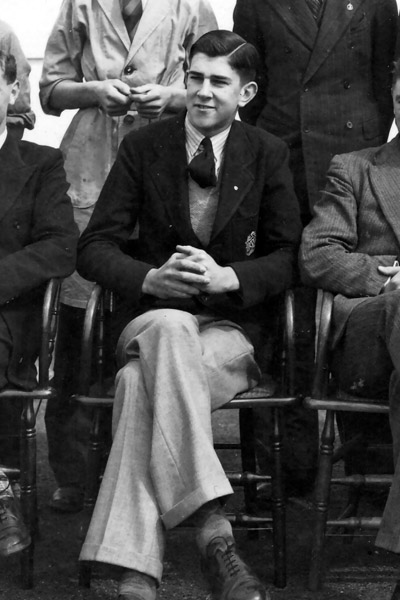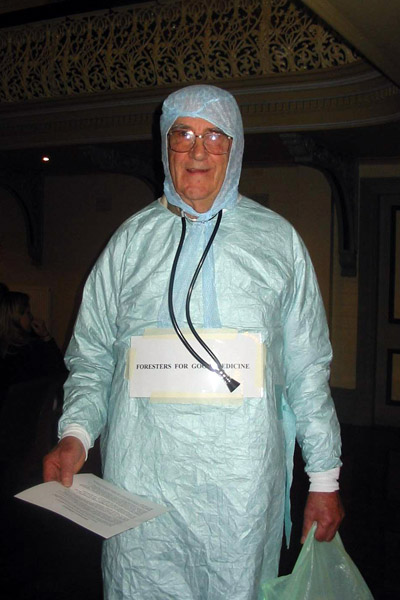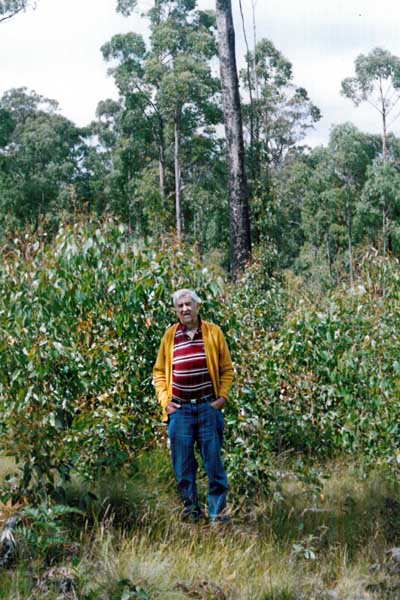Norm Endacott
The material for this article was prepared and provided by David Endacott. The article is built upon his memories and a contribution from an unknown 1950s VSF Graduate entitled Norm Endacott - A Persistent Forester, written in about 2008.
See also: Norm Endacott - PNG Forester
David's Memories
Forestry was always dear to his heart, his main commitment in life. He once said to me that a District Forester’s job was the best job in the world. It involved a perfect balance of office work - accounting, budget, personnel management and outdoor work – surveying, engineering, road and bridge construction, forest stand management and silviculture, managing sawmilling and other contractors and, of course, fire.
He was not one to avoid confrontations and troublesome issues.
On completion of his BSc in 1946-47 he briefly returned to Bruthen district, living in the married quarters at Mt Taylor with Joan and first son, yours truly, David.
Following this he was posted to Tallangatta as DFO. In those days DFOs and Assistants had to provide their own transport. Dad had a Norton 500 outfit. I can just remember coming to Melbourne in it. Other equipment was almost non-existent. If a dozer was needed local sawmillers were imposed upon to provide in the off season. The Tallangatta District received its first Ford ute and Land Rover around 1949-50.
The Land Rover acquisition is an interesting story he recounted to me some time ago. A local farmer visited him in the Tallangatta office and, coming out of the office to see him off, he spotted a strange vehicle in the drive. The cocky gave him a rundown on it and Norm was captivated. He pestered Head Office for one but was told no chance, very few coming into the country and they was no chance of FCV acquiring one. A little later he was down at the local garage getting the ute serviced and there was a new Series 1 Land Rover sitting there, for sale. Dad organised a 24 hour hold on it and pestered the hell out of Head Office. He was finally given the authority to raise a local works order for it. He claimed that it was the first time that had occurred and also it was the first FCV Land Rover. I have a recollection that Gerry Griffin pranged it and maybe wrote it off? Norm definitely pranged a Land Rover during the 1952 fires. Pulling up at the Granya pub about midnight to use their phone to ring home he forgot to yank the handbrake on and it rolled over a bank.
He got into hot water with Head Office over fuel reduction burning in the high country. HO wanted it done but wouldn’t resource it, so Norm organised the Mountain Cattlemen, whom he always respected and got on well with, to drop a few matches. He said he was on the carpet at HO and, walking past an open office door he heard someone say “get Endacott out of the North-East”. This probably triggered his transfer to Daylesford, and contributed to his eventual disillusionment with the FCV and subsequent resignation in the 1960s. On Land Rovers, I recall as a kid at Daylesford in about 1955, so it would have been a Series 2, being in the back coming home with Darby Patterson and Jack Opie in the front, can’t recall who was driving, and coming along the straight at Leonards Hill they decided to see what it would do. I think 75mph was mentioned and I was admonished not to tell my old man.
A transfer to Daylesford occurred in 1953, about a year before Tallangatta was moved to its present location and the old town flooded. Much has been written about his time at Daylesford. He told me that one year in the 1950s he achieved a record revenue for the Wombat. Fell short of the £100,000 budget by about a 100 quid. He was tempted to make it up out of his own pocket, but didn’t.
We left Daylesford in 1959 for a one year stop in Ballarat before Norm left the Forests Commission to take a position with the SEC managing the forest areas under its control. This occasioned a move to Melbourne where we bought a house in Mitcham. After a couple years with the SEC he took a position with the PNG Forests Department and for some years was based in Lae.
His last employment was out of Rome with the FAO in the Philippines. A position that proved less than fulfilling. In his usual manner he filed reports telling of the true state of reforestation projects and endemic corruption, the tone of which were not appreciated in Rome. He told me subsequently that he eventually gave up and made non-provocative reports which went down better. I think he found it a relief to head into retirement, though he took on some consultancies from time to time.
His eventual return to Australia and Victoria brought a major effort to catch up with old colleagues and the years of Victorian forestry he had missed. This period in the late 1980s was also a time of major environmental activity and change. He threw himself into that fray with gusto. On his fact finding missions to support his arguments he relished visiting his old district offices to check through files and interrogate the current staff.
The events of the last 30 years threw up many forest issues which occupied him with countless letters to the editor, emails to colleagues around the world and contact with numerous members of Parliament.
The alpine fires of 2003 left him thunderstruck. The duration, the area and the seeming difficulty the agencies had in producing an effective and timely attack were perplexing to him.
This caused him the revisit his fire – the 1952 Upper Murray fire. He produced a narrative and timeline of the fire and with assistance from staff in the Tallangatta office, mapped it - 133000 ha. There was little machinery available. The CFA was in the process of being established and had little equipment and the farmers had maybe a tractor with a water tank or a blade. Unlike 2003 the weather did not provide any periods of relief and the fire was controlled in 22 days. Norm said he was concerned about young Tom? Crosbie Morrison (Philip Crosbie Morison’s son) who was manning the Mt George tower (I think burnt in the fire?) and was missing. He wandered out of the bush a couple of days later.
In those days if the fire was in a DFO’s district it was his fire. Maybe he could hope for some assistance from neighbouring districts or head office. In 2003 it seemed the fire was being fought by the Premier’s 11am press conference!
As the new century loomed the fate of the Wombat Forest became both his main focus and despair. The Wombat as Victoria’s most managed forest was his pride, and he hoped that it would be a “working forest” in perpetuity. I think between he and Roger Underwood in the West was the term working forest originated. The eventual loss of the Wombat as a productive forest was a great blow to him and indeed to his profession, and it hurt.
The continuing assaults on the forestry profession upset and angered him. The eventual curtailment of forestry as a degree subject was inexplicable and we have probably not yet reaped all the consequences of that.
A VSF Graduates View
A Persistent Forester
The forestry profession has many unsung heroes and it is important we celebrate their stories just as much as those who reach high office or fame in a specialist field. This story is about Norman Endacott a general forest practitioner who deserves recognition for his remarkable persistence for well over 50 years in contributing to the public debate on management of native forests. At age 87 and despite rebuffs and non acceptance of his many recommendations and submissions to inquiries he continues undeterred in his promotion of multiple use forest management
I first met forester Norman Endacott in the 1950’s on a field excursion with fellow Creswick forestry students to the Wombat Forest in the Daylesford District in Central Victoria. Norman was District Forest Officer and ruler of this forest at the time when DFO’s had considerable authority; the Forests Commission informed governments what they planned to do and got on with it, not the other way round as today where endless community consultation, interminable meetings and many years often pass before a single leaf can fall in the forest. Norman was a worthy representative of that era, tall and straight as a regrowth messmate, hair the colour of Wonthaggi coal and a presence which captivated his student audience. As he spoke about silviculture it became clear that forestry was not just a means of occupying his working hours but a passion he believed in.
Born in 1921, Norman attended Hampton High School and was dux of the final year in 1937 when he decided to become a forester. How times change! Today bright students would probably choose a career in merchant banking or law and avoid a forestry career like the plague. At Creswick he topped the final year and was posted to Bruthen District in Feb 1941. He spent five years being “blooded” into the ways of sleeper cutters and district tasks including a mediation role to end a six week sleeper cutters strike. The 1946-47 years were spent at Melbourne University gaining his forestry degree following which he became District Forest Officer of the Upper Murray District in the Corryong, Tallangatta area. Road construction for fire access was a major requirement then but fierce competition for skilled machine operators for the Snowy Hydro and the Kiewa scheme in Victoria was a challenge. In a very clever way Norman recruited and trained local rural workers to form a competent construction team; badgered the Forests Commission for plant and funding resulting in many miles of roads being built. In January 1952, long before compulsory rest breaks were thought of he was involved in fire fighting for 22 days straight when much of NE Victoria was ablaze. In 1953 he transferred to Daylesford where he developed his love of silviculture. With Jack Opie he devised a valuable refinement to the existing silvicultural system.
He became the Victorian State Electricity Commission’s forester in 1959 a move he later regretted, and in 1963 joined the PNG Forest Department as a Regional Forest Officer, New Guinea Mainland Region, based on Lae. In 1970 he was promoted to Head Office in Port Moresby to work on a PNG Government proposal to promote PNG as another potential British Columbia. Never one to shrink from making his feelings clear, Norman’s observed that the proposal was “a heap of bullshit and would never work” and post-independence history has proved him right.
In 1973 he left PNG and worked in a multi disciplinary team for FAO in the Philippines. He found this frustrating because of the uncooperative style of the government and as industrial plantation expert soon discovered that despite official government reports of extensive plantations none actually existed nor was there any intention to establish any. In 1977 he joined Jaako Poyry and worked on a number of projects in different countries until 1986. This ended Stage One of his paid forestry career.
Since then and in amongst the many voluntary duties most retired foresters become involved in he has become an extraordinary independent commentator on forestry matters in Victoria. Holding fast to the principle of multiple-use management of native forests he has argued, debated and taken to task governments, politicians and environmentalists whenever they have attempted to mislead the public or use unscientific reasons to justify their actions on forestry matters. Although one of the first to recognise that use of forest science, reason or logic to counter the often illogical or untruthful messages used by militant environmentalists is usually of limited value, this has not diminished his output and I have long lost count of the submissions, letters to the Editor etc that Norman has produced. My computer file headed “Endacott” passed the 30 Mb mark long ago. He has set up information booths at the Royal Show and at several country shows all at his own expense.
Those who have had to endure the actions of duplicitous politicians and ill-mannered militant environmentalists during their forestry career, and nurtured as their secret wish that retribution might be visited on these people, will gain some amusement from the tactics used by Norman in getting his views across. One of these occasions, which is now forestry folklore in Victoria, took place when Doctors for Native Forests were campaigning strongly to eradicate all timber production from the Wombat Forest, claiming water supplies and the Hepburn Mineral Springs were being adversely affected by harvesting. To support their claim DFNF commissioned a report to be released at a public meeting in the Daylesford Town Hall. From his past knowledge of the Wombat Forest, Norman realised the claims were a nonsense and to draw attention to this, and challenge the doctors new found expertise on forestry, he stationed himself at the hall entrance dressed in a surgeons operating gear and complete with stethoscope and a placard around his neck that read, FORESTERS FOR GOOD MEDICINE & TRAINEE BRAIN SURGEON. Information sheets were handed out to the arriving crowd.
Now at age 87 and with hair no longer the colour of Wonthaggi coal he shows no signs of slowing down. Whether everyone has agreed with the positions he has taken and whether his efforts have influenced outcomes is beside the point. Sticking to one’s principles and not “going along with the tide” has characterised Norman’s approach. It is a commendable quality and, although unlikely in his lifetime, the concept of multiple use he has unwaveringly promoted will I believe in time become more acceptable to the community. The forestry profession needs more people like Norman Endacott.
Career Summary
Tenured Career
- 1938 - 1940. Vic School of Forestry Creswick (Dux Senior Year)
- 1941 - 1946. Asst Forester Bruthen District
- 1946 - 1947. Melb Uni Scholarship
- 1948 - 1953. District Forester – Upper Murray District based at Tallangatta. (Later split into 2 districts – Tallangatta & Corryong)
- 1953 - 1959. District Forest Officer Daylesford
- 1959 - Ballarat DFO
- 1960 - 1963. Chief Forestry Officer SEC
- 1963 - 1973. Regional Forest Officer PNG; first Port Moresby then New Guinea Mainland Region based in Lae. Then promoted to Head Office
- 1973 - 1977. Four year contract in Food and Agriculture/UNDP Project in Philippines.
Consultant Career
- 1978 - Jaako Poyry (UK) Private Forestry South Africa
- 1981 - 82. Jaako Poyry (Finland/Sweden). Feasability Report Fiji Pine Commission plantations
- 1982 - 1984. With ACIL (International) 2 man report team – feasibility to PNG Govt for forestry Manus Island and South Bougainville.
- 1984 - Jaako Poyry (Interforest-Swedish subsidiary) 2 man team – Feasability study for Indonesian company Northern Sumatra using original Dutch plantations of Pinus merkusii
- 1986 - Shedden Pacific on behalf of ADAB. Project completion Report on China-Australia Afforestation project Guangxi Province
- 1994 - Small consultancy for VAFI, response to East Gipps FMA Plan.
Active in:
- 1987 - Trying to stir IFA into engaging with weight in the burgeoning forest debates/crises. Unsuccessful, resigned in disgust.
- 1990s - Rounded up some old colleagues and formed a (Committee of Concerned Foresters) Lobbied politicians like Minister Coleman. With the situation clearly getting worse fizzled in about 1993
- The Forests Commission Retired Personnel Assoc, Treasurer for a time.
- Toolangi 1939 Fire Memorial
- With the small museum at Toolangi being under threat from diminishing Department support, negotiations with Indigo Shire resulted in the Museum being largely relocated and improved in the former Forests Commission Office in Beechorth (part of the Historic Court House precinct).
- Strong involvement in Otways and Wombat forest management issues.
- With the re-engagement of the IFA with Victorian forest issues, rejoined IFA.
- Tendered submissions to numerous government/department processes.
- Created some fly-by-night one man shows such as “Foresters for Good Medicine” (to counter the antics of the “Doctors for Native Forests”)

Norm Endacott
1940
Source: VSF Graduation Photo

"Dr" Norm Endacott at a forest protest meeting
Daylesford
About 1993
Source: D Endacott

Norm Endacott at Paddy's Point
Wombat Forest
2004
Source: D Endacott
